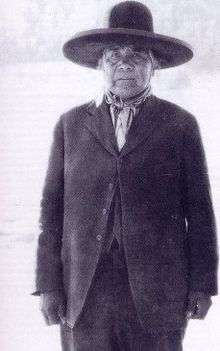Wovoka
| Wovoka | |
|---|---|
 | |
| Northern Paiute leader | |
| Personal details | |
| Born |
c. 1856 Smith Valley, Nevada |
| Died |
September 20, 1932 Yerington, Nevada |
| Resting place | Schurz, Nevada |
| Known for | Spiritual leader and creator of the Ghost Dance |
| Nickname(s) | Jack Wilson |
Wovoka (c. 1856 - September 20, 1932),[1] also known as Jack Wilson, was the Northern Paiute religious leader who founded a second episode of the Ghost Dance movement. Wovoka means "cutter"[2] or "wood cutter" in the Northern Paiute language.
Biography
Wovoka was born in the Smith Valley area southeast of Carson City, Nevada, around 1856. Quoitze Ow was his birth name.[3] Wovoka's father was Numu-tibo'o (sometimes called Tavibo), who for several decades was incorrectly believed to be Wodziwob, a religious leader who had founded the Ghost Dance of 1870.[4] From the age of eight until almost thirty Wovoka often worked for David Wilson, a rancher in the Yerington, Nevada area, and his wife Abigail, who gave him the name Jack Wilson when dealing with European Americans.[5] David Wilson was a devout Christian, and Wovoka learned Christian theology and Bible stories while living with him.[6]
One of his chief sources of authority among Paiutes was his alleged ability to control the weather. He was said to have caused a block of ice to fall out of the sky on a summer day, to be able to end drought with rain or snow, to light his pipe with the sun, and to form icicles in his hands.[7]
Wovoka claimed to have had a prophetic vision during the solar eclipse on January 1, 1889. Wovoka's vision entailed the resurrection of the Paiute dead and the removal of whites and their works from North America. Wovoka taught that in order to bring this vision to pass the Native Americans must live righteously and perform a traditional round dance, known as the Ghost dance, in a series of five-day gatherings. Wovoka's teachings spread quickly among many Native American peoples, notably the Lakota.
The Ghost Dance movement is known for being practiced by the victims of the Wounded Knee Massacre; Indian Agents, soldiers, and other federal officials were predisposed towards a militaristic posture when dealing with a movement that was so antithetical to their views and ideas. Wovoka’s preachings included messages of non-violence, but two Miniconjou, Short Bull and Kicking Bear, allegedly emphasized the possible elimination of whites which contributed to the existing defensive attitude of the federal officials who were already fearful due to the unfamiliar Ghost Dance movement.
Wovoka died in Yerington on September 20, 1932 and is interred in the Paiute Cemetery in the town of Schurz, Nevada.[8]
See also
Notes
- ↑ Clifford E. Trafzer (April 1986). American Indian prophets: religious leaders and revitalization movements. Sierra Oaks Pub. Co. p. 108. Retrieved 23 July 2013.
Wovoka, the great Ghost Dance Prophet, died on September 20, 1932 and was buried in the heart of the Paiute country. Joseph McDonald of the Reno ... his body was taken to the Paiute cemetery at Shurtz. As family and friends shoveled dirt ...
- ↑ Mooney, James (1896). The ghost-dance religion and the Sioux outbreak of 1890. G.P.O. p. 765.
- ↑ Hittman,"Wovoka And The Ghost Dance:Expanded Edition" (Lincoln, Nebraska:University of Nebraska:Press 1997) 47
- ↑ Du Bois, Cora "The 1870 Ghost Dance" Anthropological Records Vol. 3, No. 1 (1939) (Berkeley, California; University of California Press) 3-4
- ↑ Hittman, Michael Wovoka And The Ghost Dance: Expanded Edition (Lincoln, Nebraska: University of Nebraska Press 1997) 27-28
- ↑ Hittman, Wovoka 55-56
- ↑ Hittman, Michael (1990). Wovoka and the ghost dance. University of Nebraska Press. p. 69. ISBN 978-0-8032-7308-5.
- ↑ "Wovoka - Paiute Medicine Man & the Ghost Dance". Legends of America. Retrieved 2010-04-15.
Further reading
- Michael Hittman, Wovoka and the Ghost Dance, Bison Books 1998, ISBN 0-8032-7308-8
- John Norman, Ghost Dance, Daw Books 1970, (a fictional account) ISBN 0-87997-501-6
External links
- Ghostdance.us Wovoka Information
- Wovoka at Find a Grave
- The Messiah Letter by Wovoka, translated by James Mooney
- Paiute Native American shaman Wovoka and the Ghost Dance on YouTube